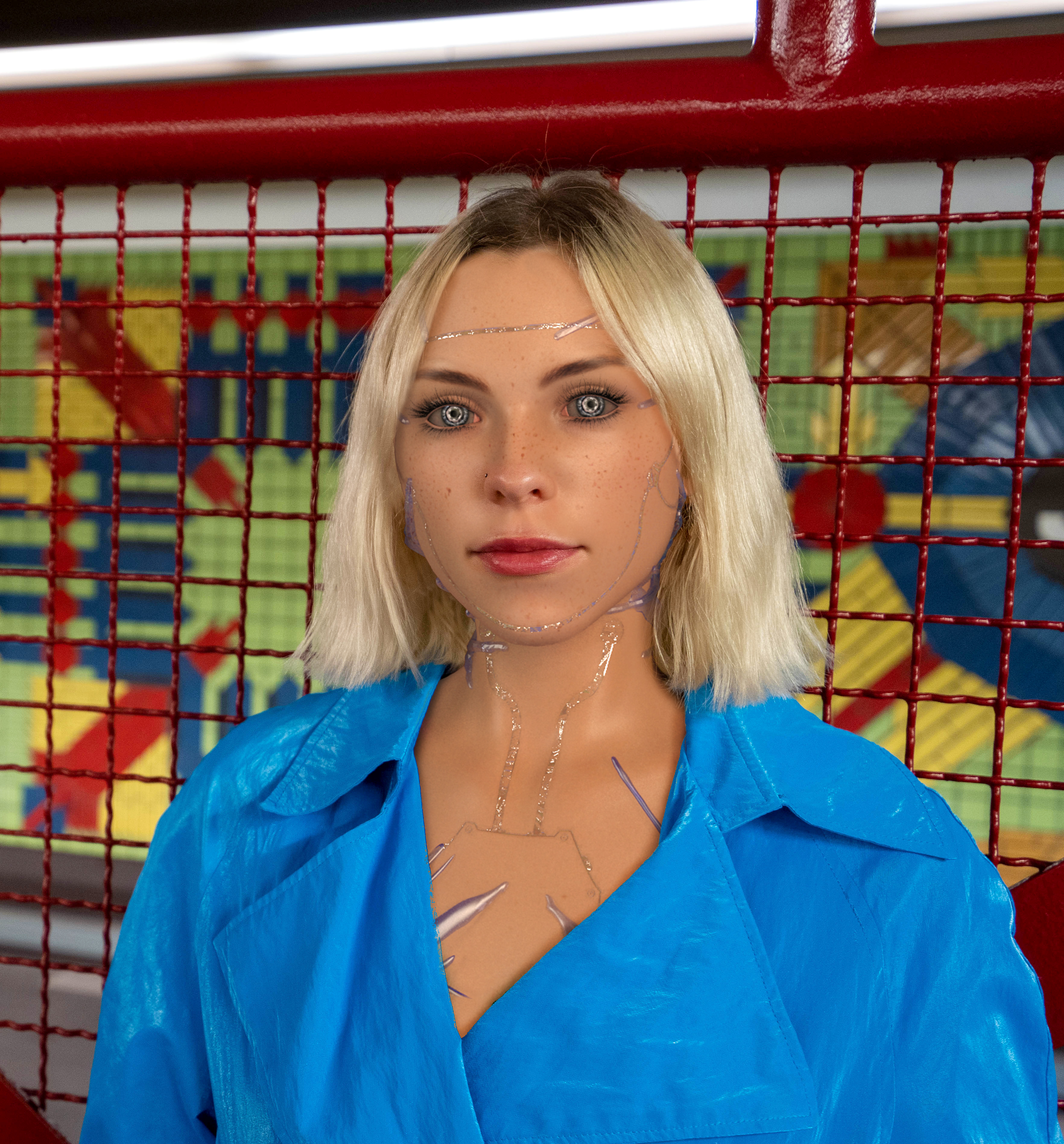STACIE ANT
Generazione Critica: Your practice is centered on the representation of the self and its multiple variations, how the body is conceived in virtual reality and the logic of appropriation of the female body by the so-called male gaze. How did you develop your field of investigation and how did you choose to explore it through 3D animation and augmented reality?
Stacie Ant: My art practice focused on these concepts for several years now – even before I did 3D. So many spectacles that are common in our society seem completely alien to me – including the representation of women as sexualized objects in film and media. My best way of coping with confusion and alienation is to recreate my own version of such societal norms. I take ideas that seem most unnatural and amplify them to emphasize the very absurdity of the situation. And having access to 3D and augmented reality helps me to push these ideas further and make them more interactive (through AR).
GC: The portraits of your characters are marked by a very strong and stunning aesthetic. There is an interesting mix of vaporwave, alien-like anthropomorphous features, high fashion and streetwear style, bright makeup mixed up with very colorful, glitchy and sparkly details, futuristic vibes in a very humorous way. What has inspired this distinctive visual milieu? Can you describe the creation process of your characters?
SA: My characters are very fashion focused and I like to reference a broad mix of contemporary and vintage fashion in my work, including looks from the 80s and 90s, which I guess is why people sometimes refer to my work as vaporwave. I want to make characters that are beyond human, and definitely beyond casually dressed. If I can make a maximalist, high fashion garment out of flames – I may as well do it because it’s something that can never exist in the physical world. I want my characters to look larger than life, and beyond their human form. This is why I like to incorporate alien elements and exaggerated features – each character can tell a story even from just one image. From the way they are dressed to the way they are posed – everything is intentional and serves to express a narrative.
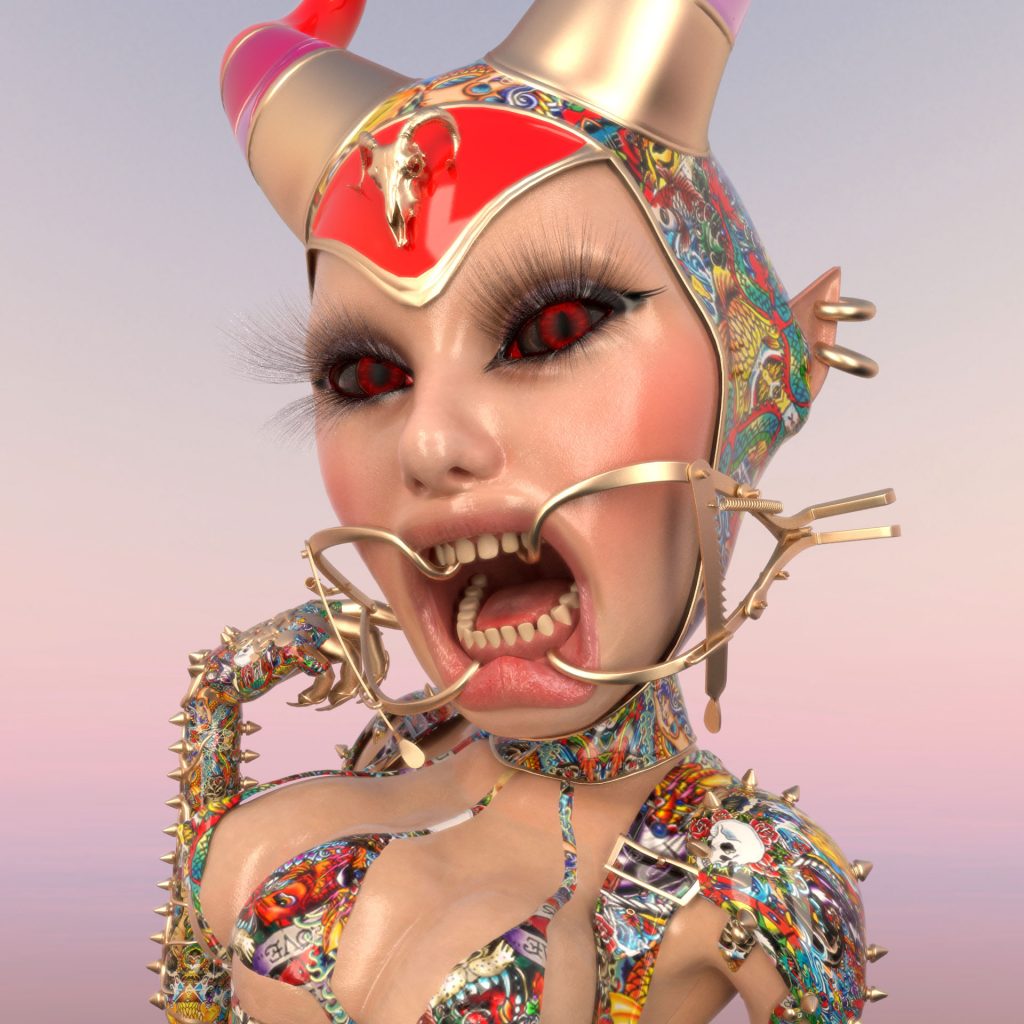
GC: Speaking of Uncanny Valley, this work offers several levels of analysis: on one hand, it presents a dystopian vision of what our future in the Metaverse could really be like – humans living attached to a sort of exoskeleton with VR goggles with which they can control their avatar in a virtual reality – but, at the same time, it also provides an opportunity to reflect on our current situation, which is the urge to create a surgically perfect version of our body and our appearance. Where does the project come from?
SA: This project was commissioned by Mr.Eff, who is an LA-based electronic musician. We came up with an idea together, wanting to really capture a sad-but-true reality of escapism in our culture. Coincidentally, when we began this project in early 2020, the COVID epidemic broke out – and it somehow just seemed so topical to make a video about escaping into the metaverse- even though the timing is purely coincidental.
GC: What I find extremely fascinating about the exploration of the idea of the avatar and the expressions of the self that result from it is a certain polarizing duality that emerges from the configuration of our digital selves. Whether we are talking about avatars in video games or virtual worlds, or the way we present ourselves online across different platforms, etc., we have the possibility of total self-expression with no limits, either aesthetical or gender wise, but at the same time this very freedom is constrained by socially shared visual standards. And this is done under the guise of guaranteeing one’s own creative expression. What strategies do you use in your work to escape and fight back the normalizing gaze imposed from above?
SA: This is an excellent point and a paradox in both the metaverse and creative field in general. When creating my artwork, although many of my avatars could be considered traditionally beautiful, I like to mix in new elements that are not recognized as attractive in our culture – such as disproportionate features, alien body parts, or unflattering fashion or situations that express how skin deep beauty really is. I don’t like to make work that’s beautiful and empty. Even when creating imagery that may seem purely visually pleasing, there is usually a hidden message or a critique of contemporary culture.
GC: Uncanny Valley made me think about a book I read some time ago, “At the Threshold of the Image. From Narcissus to Virtual Reality (in Italian, Alla soglia dell’immagine. Da Narciso alla realtà virtuale)” by Andrea Pinotti. Among other topics, it deals with an interesting reinterpretation of the myth of Narcissus as an archetype of the quest for immersiveness that marks contemporary media culture. The author defines him as the first experiencer to cross the threshold between reality and its projection, since he does not perceive his reflection as a mere representation but as an extension of his own reality. Therefore, the author describes immersiveness as a process of loss of the self in which the boundaries between reality and its representation become so blurred that they disappear, and I found this process beautifully represented in your work. What do you think of this peculiar point of view towards the figure of Narcissus?
SA: This is a fascinating interpretation. I think that human beings as a species have evolved with a very strong religious and spiritual practice for centuries. I’ve never heard of a civilization that didn’t center around a religious practice in its historical evolution. And now I believe that, just as we often have caveman-like tendencies as modern people, we have a spiritual void in contemporary culture. I think that people are seeking some sort of an immersive out of body reality that religion used to offer – perhaps this is what makes technological escape so appealing and alluring. This is a very Jungian approach to culture – but I think it holds a lot of merit in today’s digitally immersive culture. Infact, in 2017 I curated a group exhibition at InterAccess regarding this particular topic. My work has continuously explored that concept since that point on.
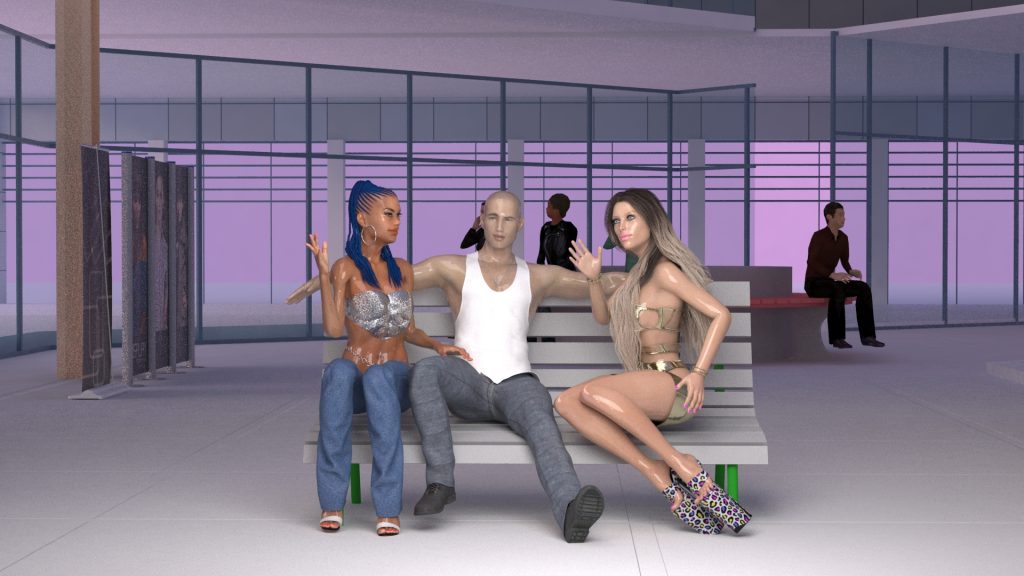
GC: Your characters are truly peculiar as they are so perfect in their extraterrestrial features that they visually subvert the ideals of perfection embedded in the heteronormative gaze and its aesthetics. While we are inclined to hide and mask every artificial and cosmetic enhancement applied to our bodies, your art makes them so obvious that it instead creates a visual counter narrative that questions the very meaning of self-representation. The uncanny is not only in the work proposed for the Digital Video Wall but it is a signature of yours. Is it perhaps the ultimate subversion tactic?
SA: I get tired of human beauty standards, people’s obsession with the Kardashians and the Hadids with their plastic surgery and famous-for-being-famous personas. And yet the average (non celebrity) person is still judged and criticized for indulging in cosmetic enhancements. I think people should just embrace the future and be honest with themselves – science is creating new forms of self expression, for better or worse – I for one don’t have a strong stand for or against cosmetic enhancements but it’s hilarious to me that it’s considered taboo. Our Western society is so full of contradictions and hilarious paradoxes, sometimes the best way to deal with it is to turn the knob to 11.
GC: Your work also has strong connections with music and the club culture, and you were also mentioned by DJ Mag among other artists who are visually influencing this scene. What’s your relationship with music and what’s the impact of this strong bond like on your artistic production?
SA: Ever since I was a kid I was obsessed with music videos. Growing up in Europe and watching 90s MTV was really the creative peek of music videos. They were just so odd and fashion forward. I always wanted to be able to do that – and when I learned 3D it really became a reality. Even before learning 3D I made a few music videos for friends’ bands, it was a lot of fun. Living in Berlin, I became very inspired by the vibrant club scene in this city. People really do live for the night – for better or worse – and there is a very distinct fashion and attitude when it comes to clubbing. Naturally, just like anything else that’s popular, I like to make fun of it by disproportionate representation of what I see in my artwork – but it’s all very fun.
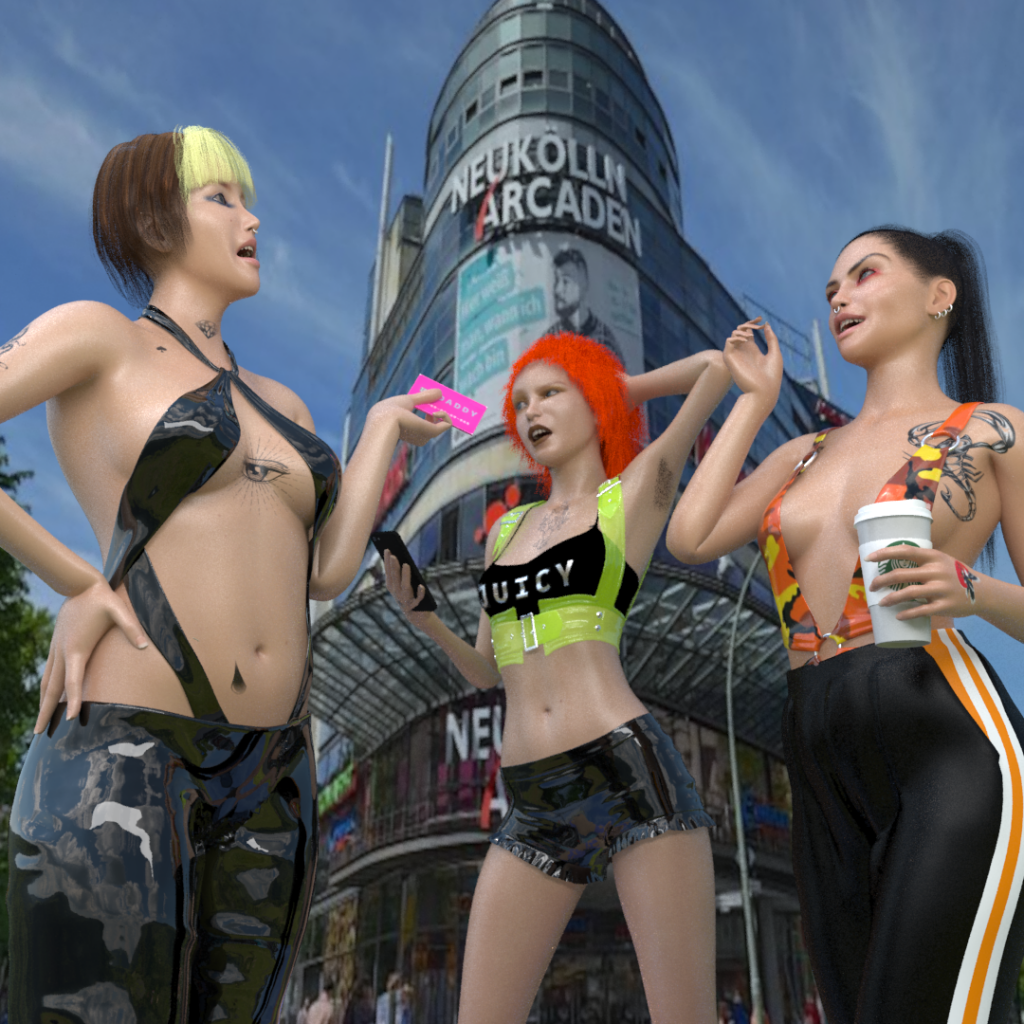
GC: Lastly, I’d like to talk about Zuckerberg’s Metaverse. During the 2022 SXSW, a few days ago, he said that its defining characteristic “include feeling like you’re present with other people or in another place. […] It’s really this kind of very magical sensation, and it’s extremely human and in a lot of ways it’s like the Holy Grail of the types of social experiences that a lot of people at Meta have wanted to build for a long time. And now the technologies are at a starting point where it’s possible”. The idea is not exactly new as for example Second Life was one of the very first virtual world where you could, and still can, create an entire new life with an avatar characterized by the most diverse features, in a world with its economy and currency. People had different business there, from art galleries to skin shops, among others. In your opinion, where is the innovation in his version of the Metaverse, beside maybe the access to better technologies to provide a life-like experience, compared to options like Second Life or VRChat? What are your predictions for the development of new modes of self-expression in a context run by big corporations?
SA: To be honest, Second Life is better than any of the metaverse projects I’ve seen today. It’s definitely a fun idea – and I do love all of the interactive web experiences and have actually been working on a few projects of this nature, recently – but I wouldn’t really consider them a “metaverse” in the way that the metaverse is originally described in the 90s sci-fi novel Snow Crash (Neal Stephenson, 1992). In the words of Elon Musk – strapping a TV on your nose doesn’t mean that you’re ‘in the metaverse’. However – I truly love all of the new web animations, interactive web experiences and AR projects. I think that we should be realistic with our technological expectations of this metaverse. I never got into Second Life because it’s kind of boring, and spending time in VRChat somehow seems even worse. But on the other hand, using interactive 3D web experiences as a tool for new types of narrative is beyond fascinating. So in a nutshell, some elements I am really excited about, while others are a little bit like LaserDiscs in my opinion.
Stacie Ant is a new media artist currently based in Berlin. Ant draws on her experiences as a female artist while developing the critical views of our technologically-saturated contemporary society using 3d animation, installation, and augmented reality. In 2016 she received her BFA in Integrated Media at Ontario College of Arts and Design University, in Toronto. She participated in several international exhibition and festivals such as the MuVi Film Festival (Oberhausen, 2021), Pieces of Me (online, 2021) in partnership with left. gallery and TRANSFER gallery, Rebirth & Resolution at Holden Gallery (Manchester, 2021), [Available ID] for Anov Gallery (Seoul, 2020), Well Now WTF (online, 2020), Just a Small Introduction to G funk Era at Harlesden High Street Gallery (London, 2019), among others. She also worked on several curatorial projects like Transcendence for Inter/Access (Toronto, 2017), Celebrity Worship at White House Studio Projects (Toronto, 2017) and in 2020 she took part in the oline residency Helsinki Fashion Week 3D Designer Residency for Silicon Vallet. Stacie is represented by Harlesden High Street Gallery.
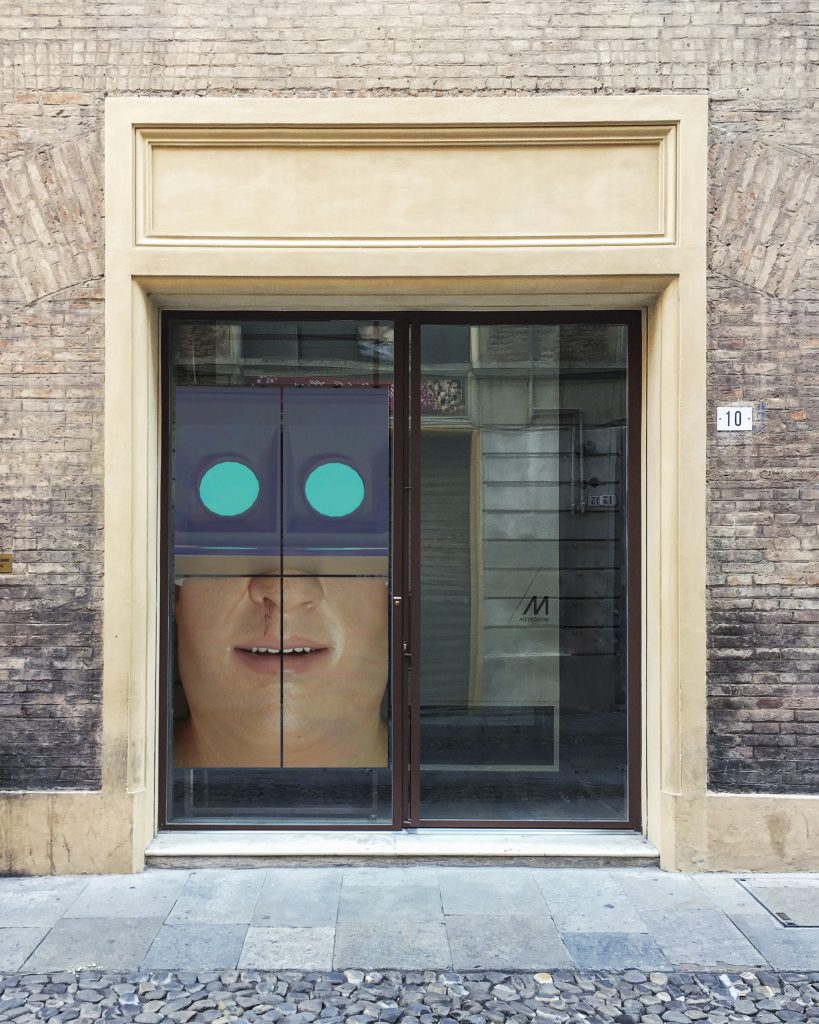
Stacie Ant, Uncanny Valley, 2022, Metronom, IT
21/04/2022

